Business Law Assignment
VerifiedAdded on 2020/03/23
|9
|2851
|84
Report
AI Summary
This report delves into the intricacies of contract law, outlining the essential components required for a legally binding contract, including offer, acceptance, consideration, and the importance of clarity and intention. It discusses the differences between written and verbal contracts, emphasizing the advantages of written agreements. The report also covers formal contracts and agency law, providing relevant case studies to illustrate key points. Overall, it serves as a comprehensive guide for understanding the principles of business law.

Business Law Assignment
Contract
19-Sep-17
(Student Details: )
Contract
19-Sep-17
(Student Details: )
Paraphrase This Document
Need a fresh take? Get an instant paraphrase of this document with our AI Paraphraser
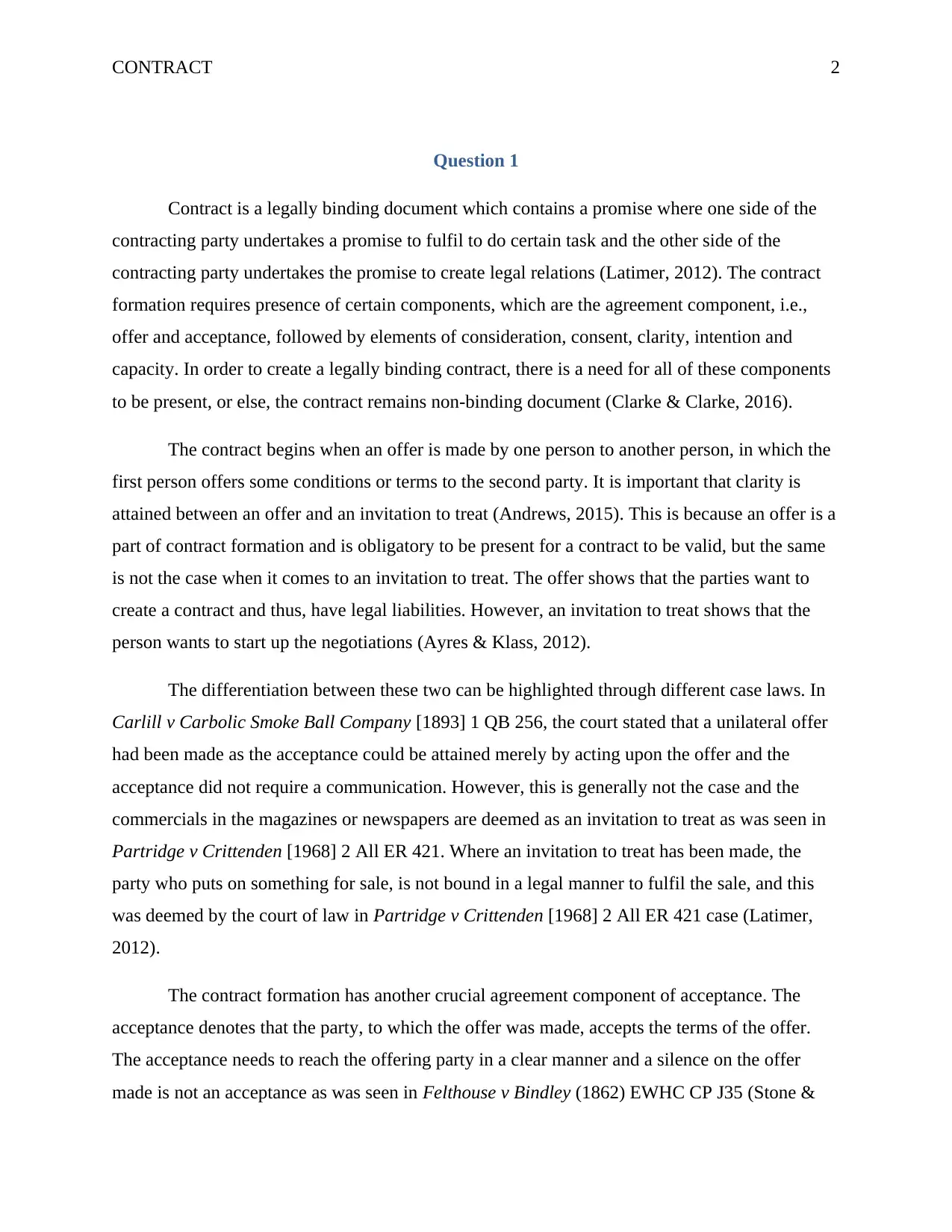
CONTRACT 2
Question 1
Contract is a legally binding document which contains a promise where one side of the
contracting party undertakes a promise to fulfil to do certain task and the other side of the
contracting party undertakes the promise to create legal relations (Latimer, 2012). The contract
formation requires presence of certain components, which are the agreement component, i.e.,
offer and acceptance, followed by elements of consideration, consent, clarity, intention and
capacity. In order to create a legally binding contract, there is a need for all of these components
to be present, or else, the contract remains non-binding document (Clarke & Clarke, 2016).
The contract begins when an offer is made by one person to another person, in which the
first person offers some conditions or terms to the second party. It is important that clarity is
attained between an offer and an invitation to treat (Andrews, 2015). This is because an offer is a
part of contract formation and is obligatory to be present for a contract to be valid, but the same
is not the case when it comes to an invitation to treat. The offer shows that the parties want to
create a contract and thus, have legal liabilities. However, an invitation to treat shows that the
person wants to start up the negotiations (Ayres & Klass, 2012).
The differentiation between these two can be highlighted through different case laws. In
Carlill v Carbolic Smoke Ball Company [1893] 1 QB 256, the court stated that a unilateral offer
had been made as the acceptance could be attained merely by acting upon the offer and the
acceptance did not require a communication. However, this is generally not the case and the
commercials in the magazines or newspapers are deemed as an invitation to treat as was seen in
Partridge v Crittenden [1968] 2 All ER 421. Where an invitation to treat has been made, the
party who puts on something for sale, is not bound in a legal manner to fulfil the sale, and this
was deemed by the court of law in Partridge v Crittenden [1968] 2 All ER 421 case (Latimer,
2012).
The contract formation has another crucial agreement component of acceptance. The
acceptance denotes that the party, to which the offer was made, accepts the terms of the offer.
The acceptance needs to reach the offering party in a clear manner and a silence on the offer
made is not an acceptance as was seen in Felthouse v Bindley (1862) EWHC CP J35 (Stone &
Question 1
Contract is a legally binding document which contains a promise where one side of the
contracting party undertakes a promise to fulfil to do certain task and the other side of the
contracting party undertakes the promise to create legal relations (Latimer, 2012). The contract
formation requires presence of certain components, which are the agreement component, i.e.,
offer and acceptance, followed by elements of consideration, consent, clarity, intention and
capacity. In order to create a legally binding contract, there is a need for all of these components
to be present, or else, the contract remains non-binding document (Clarke & Clarke, 2016).
The contract begins when an offer is made by one person to another person, in which the
first person offers some conditions or terms to the second party. It is important that clarity is
attained between an offer and an invitation to treat (Andrews, 2015). This is because an offer is a
part of contract formation and is obligatory to be present for a contract to be valid, but the same
is not the case when it comes to an invitation to treat. The offer shows that the parties want to
create a contract and thus, have legal liabilities. However, an invitation to treat shows that the
person wants to start up the negotiations (Ayres & Klass, 2012).
The differentiation between these two can be highlighted through different case laws. In
Carlill v Carbolic Smoke Ball Company [1893] 1 QB 256, the court stated that a unilateral offer
had been made as the acceptance could be attained merely by acting upon the offer and the
acceptance did not require a communication. However, this is generally not the case and the
commercials in the magazines or newspapers are deemed as an invitation to treat as was seen in
Partridge v Crittenden [1968] 2 All ER 421. Where an invitation to treat has been made, the
party who puts on something for sale, is not bound in a legal manner to fulfil the sale, and this
was deemed by the court of law in Partridge v Crittenden [1968] 2 All ER 421 case (Latimer,
2012).
The contract formation has another crucial agreement component of acceptance. The
acceptance denotes that the party, to which the offer was made, accepts the terms of the offer.
The acceptance needs to reach the offering party in a clear manner and a silence on the offer
made is not an acceptance as was seen in Felthouse v Bindley (1862) EWHC CP J35 (Stone &
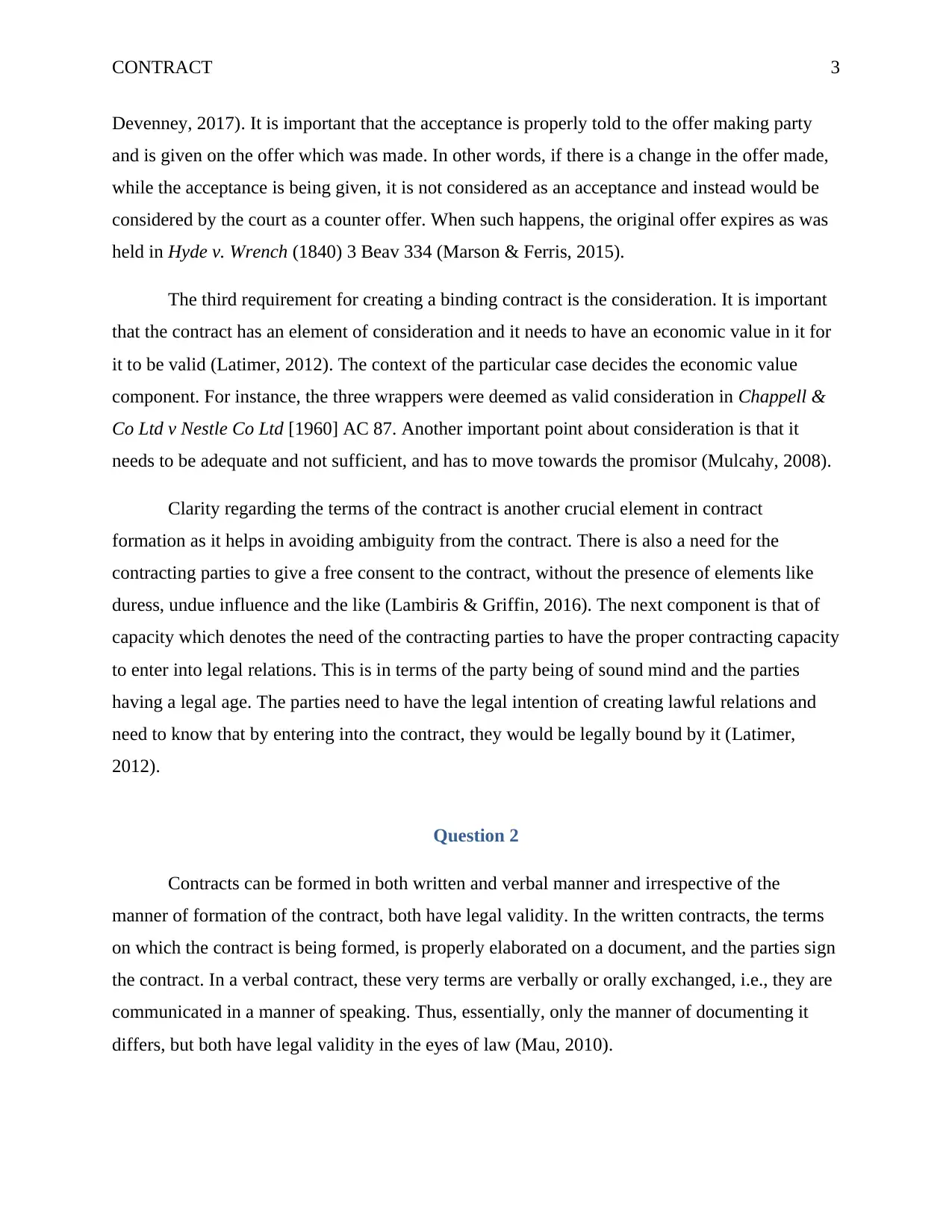
CONTRACT 3
Devenney, 2017). It is important that the acceptance is properly told to the offer making party
and is given on the offer which was made. In other words, if there is a change in the offer made,
while the acceptance is being given, it is not considered as an acceptance and instead would be
considered by the court as a counter offer. When such happens, the original offer expires as was
held in Hyde v. Wrench (1840) 3 Beav 334 (Marson & Ferris, 2015).
The third requirement for creating a binding contract is the consideration. It is important
that the contract has an element of consideration and it needs to have an economic value in it for
it to be valid (Latimer, 2012). The context of the particular case decides the economic value
component. For instance, the three wrappers were deemed as valid consideration in Chappell &
Co Ltd v Nestle Co Ltd [1960] AC 87. Another important point about consideration is that it
needs to be adequate and not sufficient, and has to move towards the promisor (Mulcahy, 2008).
Clarity regarding the terms of the contract is another crucial element in contract
formation as it helps in avoiding ambiguity from the contract. There is also a need for the
contracting parties to give a free consent to the contract, without the presence of elements like
duress, undue influence and the like (Lambiris & Griffin, 2016). The next component is that of
capacity which denotes the need of the contracting parties to have the proper contracting capacity
to enter into legal relations. This is in terms of the party being of sound mind and the parties
having a legal age. The parties need to have the legal intention of creating lawful relations and
need to know that by entering into the contract, they would be legally bound by it (Latimer,
2012).
Question 2
Contracts can be formed in both written and verbal manner and irrespective of the
manner of formation of the contract, both have legal validity. In the written contracts, the terms
on which the contract is being formed, is properly elaborated on a document, and the parties sign
the contract. In a verbal contract, these very terms are verbally or orally exchanged, i.e., they are
communicated in a manner of speaking. Thus, essentially, only the manner of documenting it
differs, but both have legal validity in the eyes of law (Mau, 2010).
Devenney, 2017). It is important that the acceptance is properly told to the offer making party
and is given on the offer which was made. In other words, if there is a change in the offer made,
while the acceptance is being given, it is not considered as an acceptance and instead would be
considered by the court as a counter offer. When such happens, the original offer expires as was
held in Hyde v. Wrench (1840) 3 Beav 334 (Marson & Ferris, 2015).
The third requirement for creating a binding contract is the consideration. It is important
that the contract has an element of consideration and it needs to have an economic value in it for
it to be valid (Latimer, 2012). The context of the particular case decides the economic value
component. For instance, the three wrappers were deemed as valid consideration in Chappell &
Co Ltd v Nestle Co Ltd [1960] AC 87. Another important point about consideration is that it
needs to be adequate and not sufficient, and has to move towards the promisor (Mulcahy, 2008).
Clarity regarding the terms of the contract is another crucial element in contract
formation as it helps in avoiding ambiguity from the contract. There is also a need for the
contracting parties to give a free consent to the contract, without the presence of elements like
duress, undue influence and the like (Lambiris & Griffin, 2016). The next component is that of
capacity which denotes the need of the contracting parties to have the proper contracting capacity
to enter into legal relations. This is in terms of the party being of sound mind and the parties
having a legal age. The parties need to have the legal intention of creating lawful relations and
need to know that by entering into the contract, they would be legally bound by it (Latimer,
2012).
Question 2
Contracts can be formed in both written and verbal manner and irrespective of the
manner of formation of the contract, both have legal validity. In the written contracts, the terms
on which the contract is being formed, is properly elaborated on a document, and the parties sign
the contract. In a verbal contract, these very terms are verbally or orally exchanged, i.e., they are
communicated in a manner of speaking. Thus, essentially, only the manner of documenting it
differs, but both have legal validity in the eyes of law (Mau, 2010).
⊘ This is a preview!⊘
Do you want full access?
Subscribe today to unlock all pages.

Trusted by 1+ million students worldwide
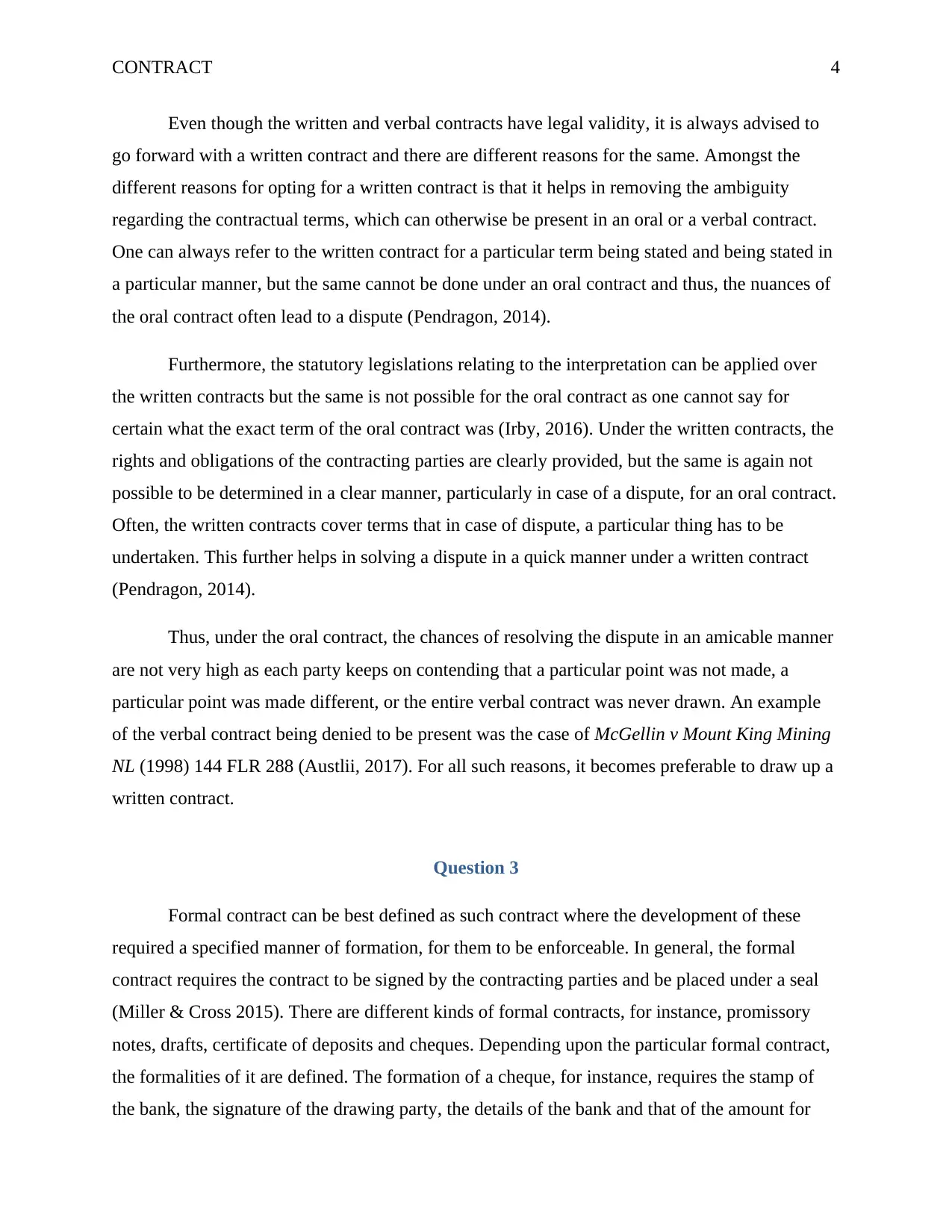
CONTRACT 4
Even though the written and verbal contracts have legal validity, it is always advised to
go forward with a written contract and there are different reasons for the same. Amongst the
different reasons for opting for a written contract is that it helps in removing the ambiguity
regarding the contractual terms, which can otherwise be present in an oral or a verbal contract.
One can always refer to the written contract for a particular term being stated and being stated in
a particular manner, but the same cannot be done under an oral contract and thus, the nuances of
the oral contract often lead to a dispute (Pendragon, 2014).
Furthermore, the statutory legislations relating to the interpretation can be applied over
the written contracts but the same is not possible for the oral contract as one cannot say for
certain what the exact term of the oral contract was (Irby, 2016). Under the written contracts, the
rights and obligations of the contracting parties are clearly provided, but the same is again not
possible to be determined in a clear manner, particularly in case of a dispute, for an oral contract.
Often, the written contracts cover terms that in case of dispute, a particular thing has to be
undertaken. This further helps in solving a dispute in a quick manner under a written contract
(Pendragon, 2014).
Thus, under the oral contract, the chances of resolving the dispute in an amicable manner
are not very high as each party keeps on contending that a particular point was not made, a
particular point was made different, or the entire verbal contract was never drawn. An example
of the verbal contract being denied to be present was the case of McGellin v Mount King Mining
NL (1998) 144 FLR 288 (Austlii, 2017). For all such reasons, it becomes preferable to draw up a
written contract.
Question 3
Formal contract can be best defined as such contract where the development of these
required a specified manner of formation, for them to be enforceable. In general, the formal
contract requires the contract to be signed by the contracting parties and be placed under a seal
(Miller & Cross 2015). There are different kinds of formal contracts, for instance, promissory
notes, drafts, certificate of deposits and cheques. Depending upon the particular formal contract,
the formalities of it are defined. The formation of a cheque, for instance, requires the stamp of
the bank, the signature of the drawing party, the details of the bank and that of the amount for
Even though the written and verbal contracts have legal validity, it is always advised to
go forward with a written contract and there are different reasons for the same. Amongst the
different reasons for opting for a written contract is that it helps in removing the ambiguity
regarding the contractual terms, which can otherwise be present in an oral or a verbal contract.
One can always refer to the written contract for a particular term being stated and being stated in
a particular manner, but the same cannot be done under an oral contract and thus, the nuances of
the oral contract often lead to a dispute (Pendragon, 2014).
Furthermore, the statutory legislations relating to the interpretation can be applied over
the written contracts but the same is not possible for the oral contract as one cannot say for
certain what the exact term of the oral contract was (Irby, 2016). Under the written contracts, the
rights and obligations of the contracting parties are clearly provided, but the same is again not
possible to be determined in a clear manner, particularly in case of a dispute, for an oral contract.
Often, the written contracts cover terms that in case of dispute, a particular thing has to be
undertaken. This further helps in solving a dispute in a quick manner under a written contract
(Pendragon, 2014).
Thus, under the oral contract, the chances of resolving the dispute in an amicable manner
are not very high as each party keeps on contending that a particular point was not made, a
particular point was made different, or the entire verbal contract was never drawn. An example
of the verbal contract being denied to be present was the case of McGellin v Mount King Mining
NL (1998) 144 FLR 288 (Austlii, 2017). For all such reasons, it becomes preferable to draw up a
written contract.
Question 3
Formal contract can be best defined as such contract where the development of these
required a specified manner of formation, for them to be enforceable. In general, the formal
contract requires the contract to be signed by the contracting parties and be placed under a seal
(Miller & Cross 2015). There are different kinds of formal contracts, for instance, promissory
notes, drafts, certificate of deposits and cheques. Depending upon the particular formal contract,
the formalities of it are defined. The formation of a cheque, for instance, requires the stamp of
the bank, the signature of the drawing party, the details of the bank and that of the amount for
Paraphrase This Document
Need a fresh take? Get an instant paraphrase of this document with our AI Paraphraser
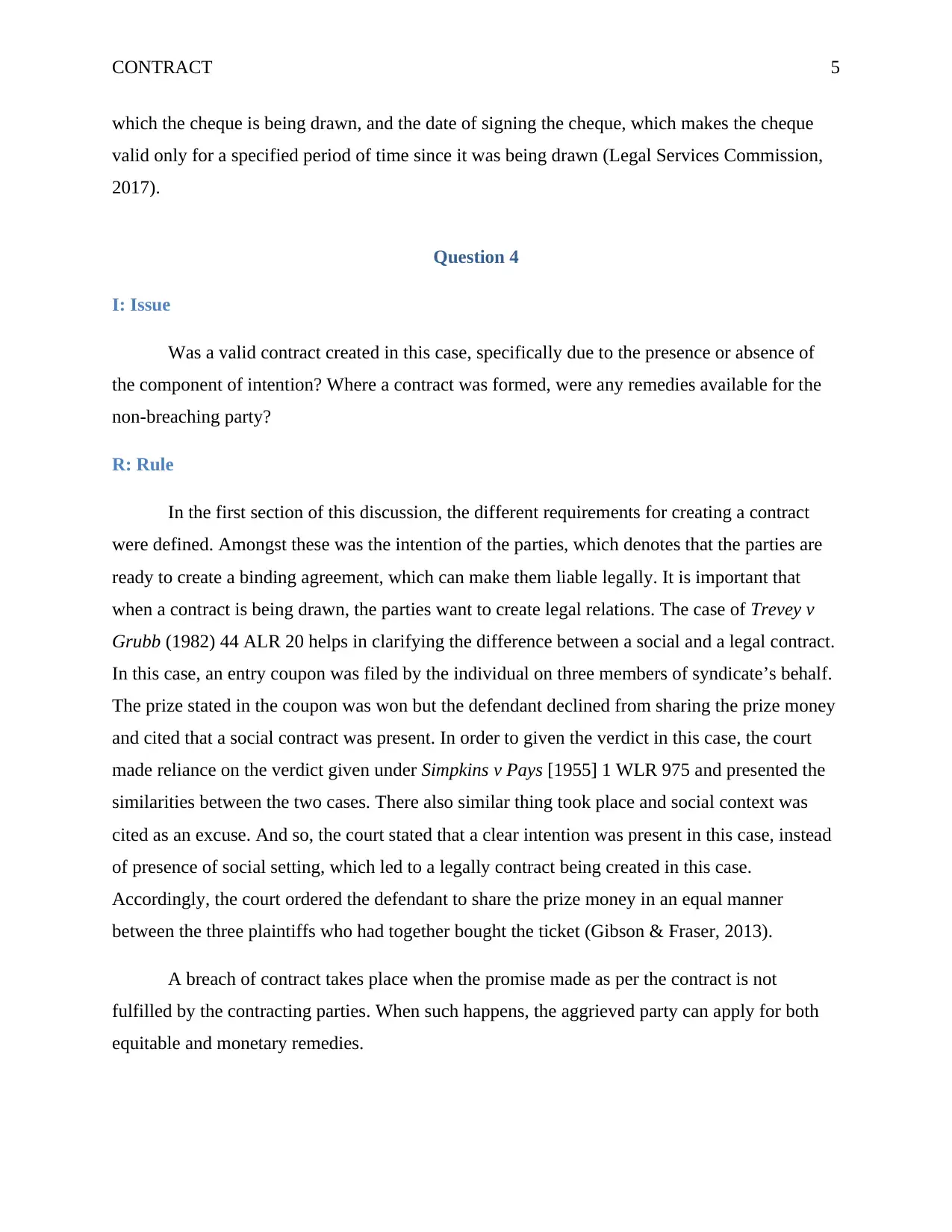
CONTRACT 5
which the cheque is being drawn, and the date of signing the cheque, which makes the cheque
valid only for a specified period of time since it was being drawn (Legal Services Commission,
2017).
Question 4
I: Issue
Was a valid contract created in this case, specifically due to the presence or absence of
the component of intention? Where a contract was formed, were any remedies available for the
non-breaching party?
R: Rule
In the first section of this discussion, the different requirements for creating a contract
were defined. Amongst these was the intention of the parties, which denotes that the parties are
ready to create a binding agreement, which can make them liable legally. It is important that
when a contract is being drawn, the parties want to create legal relations. The case of Trevey v
Grubb (1982) 44 ALR 20 helps in clarifying the difference between a social and a legal contract.
In this case, an entry coupon was filed by the individual on three members of syndicate’s behalf.
The prize stated in the coupon was won but the defendant declined from sharing the prize money
and cited that a social contract was present. In order to given the verdict in this case, the court
made reliance on the verdict given under Simpkins v Pays [1955] 1 WLR 975 and presented the
similarities between the two cases. There also similar thing took place and social context was
cited as an excuse. And so, the court stated that a clear intention was present in this case, instead
of presence of social setting, which led to a legally contract being created in this case.
Accordingly, the court ordered the defendant to share the prize money in an equal manner
between the three plaintiffs who had together bought the ticket (Gibson & Fraser, 2013).
A breach of contract takes place when the promise made as per the contract is not
fulfilled by the contracting parties. When such happens, the aggrieved party can apply for both
equitable and monetary remedies.
which the cheque is being drawn, and the date of signing the cheque, which makes the cheque
valid only for a specified period of time since it was being drawn (Legal Services Commission,
2017).
Question 4
I: Issue
Was a valid contract created in this case, specifically due to the presence or absence of
the component of intention? Where a contract was formed, were any remedies available for the
non-breaching party?
R: Rule
In the first section of this discussion, the different requirements for creating a contract
were defined. Amongst these was the intention of the parties, which denotes that the parties are
ready to create a binding agreement, which can make them liable legally. It is important that
when a contract is being drawn, the parties want to create legal relations. The case of Trevey v
Grubb (1982) 44 ALR 20 helps in clarifying the difference between a social and a legal contract.
In this case, an entry coupon was filed by the individual on three members of syndicate’s behalf.
The prize stated in the coupon was won but the defendant declined from sharing the prize money
and cited that a social contract was present. In order to given the verdict in this case, the court
made reliance on the verdict given under Simpkins v Pays [1955] 1 WLR 975 and presented the
similarities between the two cases. There also similar thing took place and social context was
cited as an excuse. And so, the court stated that a clear intention was present in this case, instead
of presence of social setting, which led to a legally contract being created in this case.
Accordingly, the court ordered the defendant to share the prize money in an equal manner
between the three plaintiffs who had together bought the ticket (Gibson & Fraser, 2013).
A breach of contract takes place when the promise made as per the contract is not
fulfilled by the contracting parties. When such happens, the aggrieved party can apply for both
equitable and monetary remedies.
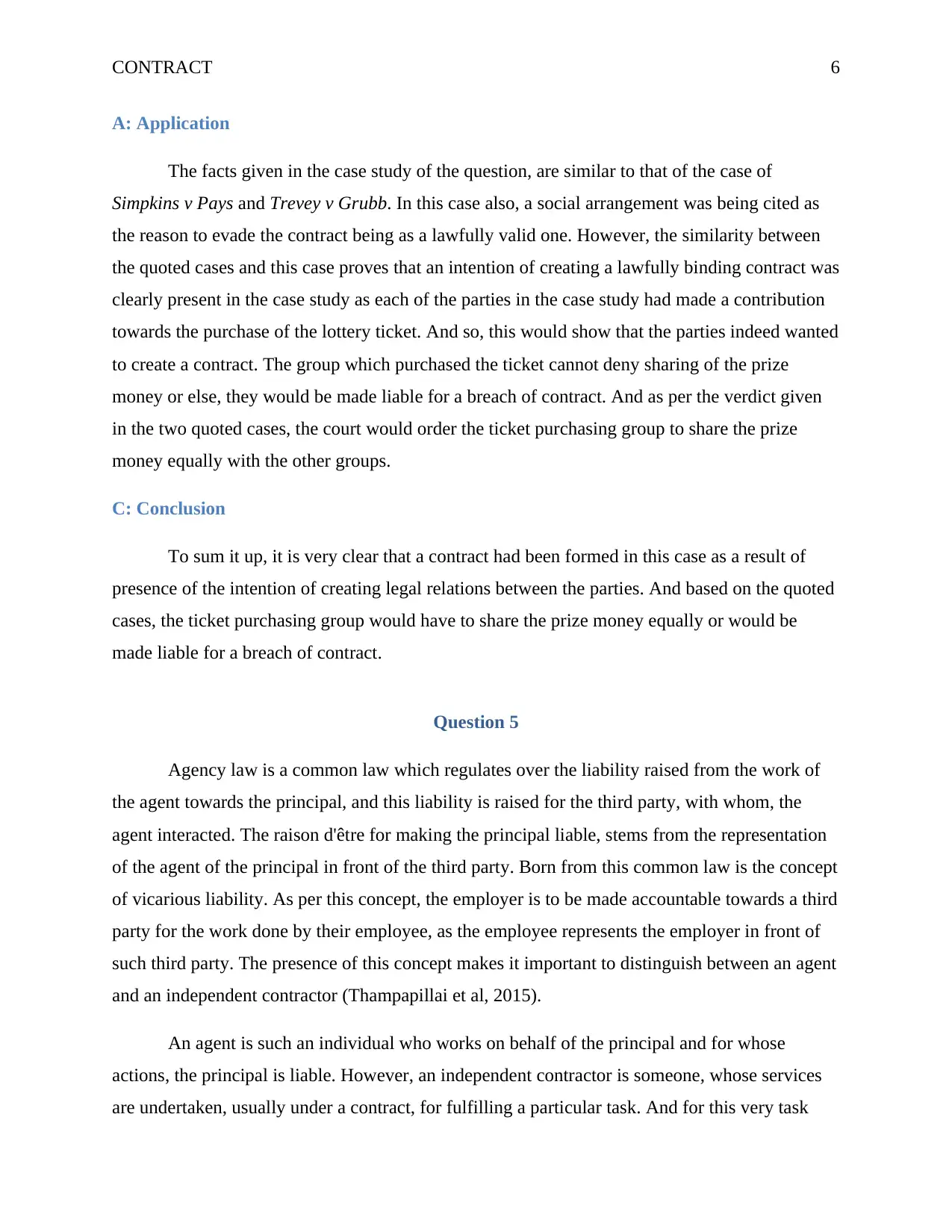
CONTRACT 6
A: Application
The facts given in the case study of the question, are similar to that of the case of
Simpkins v Pays and Trevey v Grubb. In this case also, a social arrangement was being cited as
the reason to evade the contract being as a lawfully valid one. However, the similarity between
the quoted cases and this case proves that an intention of creating a lawfully binding contract was
clearly present in the case study as each of the parties in the case study had made a contribution
towards the purchase of the lottery ticket. And so, this would show that the parties indeed wanted
to create a contract. The group which purchased the ticket cannot deny sharing of the prize
money or else, they would be made liable for a breach of contract. And as per the verdict given
in the two quoted cases, the court would order the ticket purchasing group to share the prize
money equally with the other groups.
C: Conclusion
To sum it up, it is very clear that a contract had been formed in this case as a result of
presence of the intention of creating legal relations between the parties. And based on the quoted
cases, the ticket purchasing group would have to share the prize money equally or would be
made liable for a breach of contract.
Question 5
Agency law is a common law which regulates over the liability raised from the work of
the agent towards the principal, and this liability is raised for the third party, with whom, the
agent interacted. The raison d'être for making the principal liable, stems from the representation
of the agent of the principal in front of the third party. Born from this common law is the concept
of vicarious liability. As per this concept, the employer is to be made accountable towards a third
party for the work done by their employee, as the employee represents the employer in front of
such third party. The presence of this concept makes it important to distinguish between an agent
and an independent contractor (Thampapillai et al, 2015).
An agent is such an individual who works on behalf of the principal and for whose
actions, the principal is liable. However, an independent contractor is someone, whose services
are undertaken, usually under a contract, for fulfilling a particular task. And for this very task
A: Application
The facts given in the case study of the question, are similar to that of the case of
Simpkins v Pays and Trevey v Grubb. In this case also, a social arrangement was being cited as
the reason to evade the contract being as a lawfully valid one. However, the similarity between
the quoted cases and this case proves that an intention of creating a lawfully binding contract was
clearly present in the case study as each of the parties in the case study had made a contribution
towards the purchase of the lottery ticket. And so, this would show that the parties indeed wanted
to create a contract. The group which purchased the ticket cannot deny sharing of the prize
money or else, they would be made liable for a breach of contract. And as per the verdict given
in the two quoted cases, the court would order the ticket purchasing group to share the prize
money equally with the other groups.
C: Conclusion
To sum it up, it is very clear that a contract had been formed in this case as a result of
presence of the intention of creating legal relations between the parties. And based on the quoted
cases, the ticket purchasing group would have to share the prize money equally or would be
made liable for a breach of contract.
Question 5
Agency law is a common law which regulates over the liability raised from the work of
the agent towards the principal, and this liability is raised for the third party, with whom, the
agent interacted. The raison d'être for making the principal liable, stems from the representation
of the agent of the principal in front of the third party. Born from this common law is the concept
of vicarious liability. As per this concept, the employer is to be made accountable towards a third
party for the work done by their employee, as the employee represents the employer in front of
such third party. The presence of this concept makes it important to distinguish between an agent
and an independent contractor (Thampapillai et al, 2015).
An agent is such an individual who works on behalf of the principal and for whose
actions, the principal is liable. However, an independent contractor is someone, whose services
are undertaken, usually under a contract, for fulfilling a particular task. And for this very task
⊘ This is a preview!⊘
Do you want full access?
Subscribe today to unlock all pages.

Trusted by 1+ million students worldwide
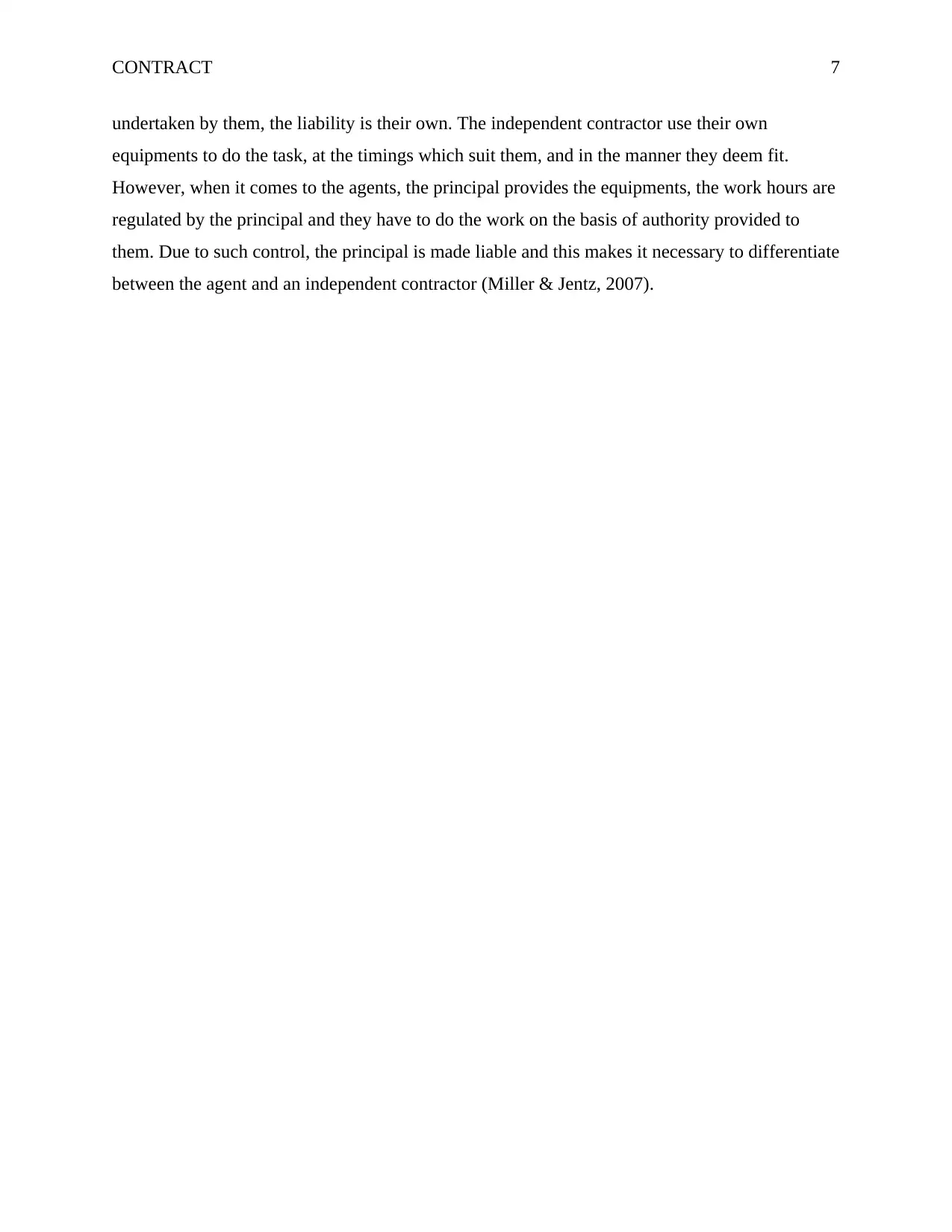
CONTRACT 7
undertaken by them, the liability is their own. The independent contractor use their own
equipments to do the task, at the timings which suit them, and in the manner they deem fit.
However, when it comes to the agents, the principal provides the equipments, the work hours are
regulated by the principal and they have to do the work on the basis of authority provided to
them. Due to such control, the principal is made liable and this makes it necessary to differentiate
between the agent and an independent contractor (Miller & Jentz, 2007).
undertaken by them, the liability is their own. The independent contractor use their own
equipments to do the task, at the timings which suit them, and in the manner they deem fit.
However, when it comes to the agents, the principal provides the equipments, the work hours are
regulated by the principal and they have to do the work on the basis of authority provided to
them. Due to such control, the principal is made liable and this makes it necessary to differentiate
between the agent and an independent contractor (Miller & Jentz, 2007).
Paraphrase This Document
Need a fresh take? Get an instant paraphrase of this document with our AI Paraphraser
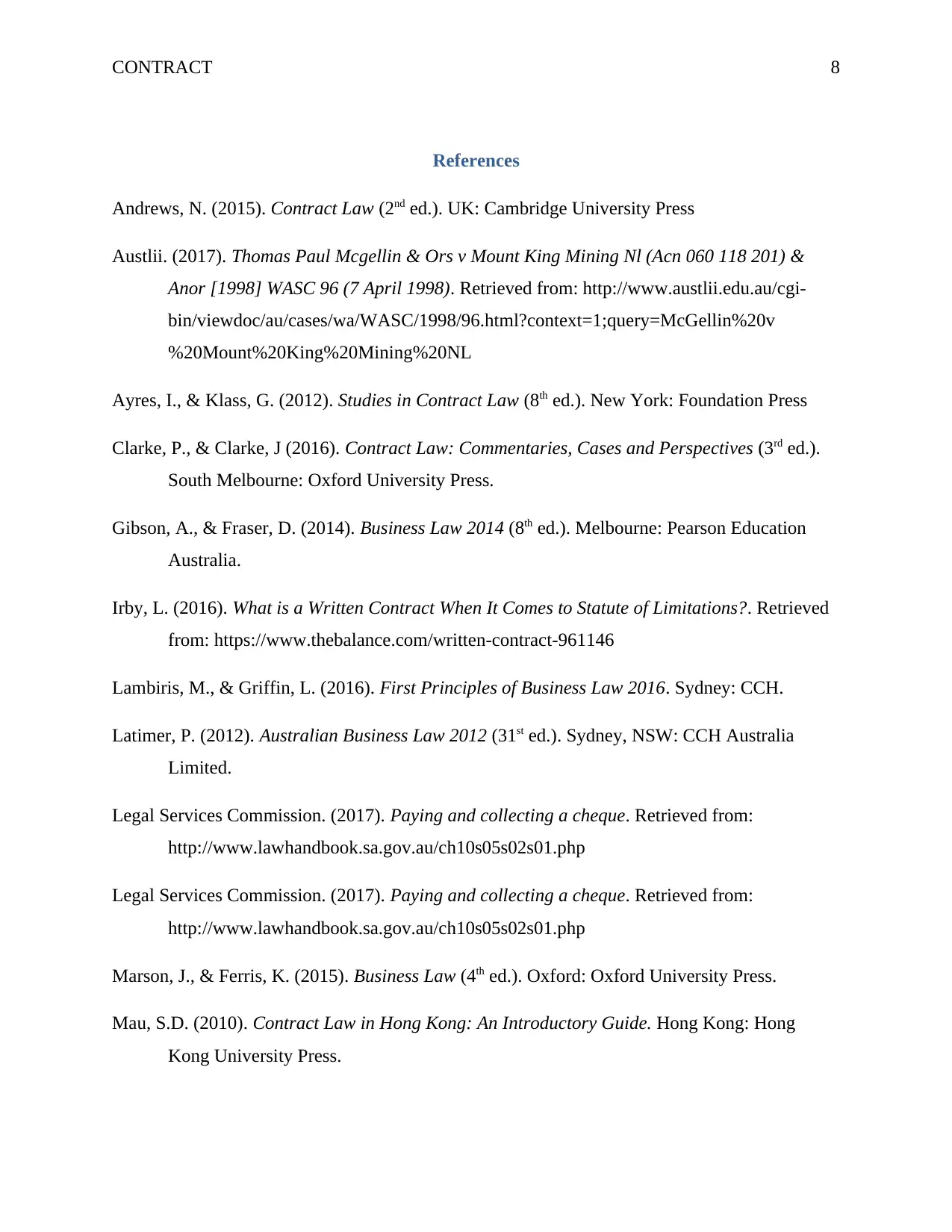
CONTRACT 8
References
Andrews, N. (2015). Contract Law (2nd ed.). UK: Cambridge University Press
Austlii. (2017). Thomas Paul Mcgellin & Ors v Mount King Mining Nl (Acn 060 118 201) &
Anor [1998] WASC 96 (7 April 1998). Retrieved from: http://www.austlii.edu.au/cgi-
bin/viewdoc/au/cases/wa/WASC/1998/96.html?context=1;query=McGellin%20v
%20Mount%20King%20Mining%20NL
Ayres, I., & Klass, G. (2012). Studies in Contract Law (8th ed.). New York: Foundation Press
Clarke, P., & Clarke, J (2016). Contract Law: Commentaries, Cases and Perspectives (3rd ed.).
South Melbourne: Oxford University Press.
Gibson, A., & Fraser, D. (2014). Business Law 2014 (8th ed.). Melbourne: Pearson Education
Australia.
Irby, L. (2016). What is a Written Contract When It Comes to Statute of Limitations?. Retrieved
from: https://www.thebalance.com/written-contract-961146
Lambiris, M., & Griffin, L. (2016). First Principles of Business Law 2016. Sydney: CCH.
Latimer, P. (2012). Australian Business Law 2012 (31st ed.). Sydney, NSW: CCH Australia
Limited.
Legal Services Commission. (2017). Paying and collecting a cheque. Retrieved from:
http://www.lawhandbook.sa.gov.au/ch10s05s02s01.php
Legal Services Commission. (2017). Paying and collecting a cheque. Retrieved from:
http://www.lawhandbook.sa.gov.au/ch10s05s02s01.php
Marson, J., & Ferris, K. (2015). Business Law (4th ed.). Oxford: Oxford University Press.
Mau, S.D. (2010). Contract Law in Hong Kong: An Introductory Guide. Hong Kong: Hong
Kong University Press.
References
Andrews, N. (2015). Contract Law (2nd ed.). UK: Cambridge University Press
Austlii. (2017). Thomas Paul Mcgellin & Ors v Mount King Mining Nl (Acn 060 118 201) &
Anor [1998] WASC 96 (7 April 1998). Retrieved from: http://www.austlii.edu.au/cgi-
bin/viewdoc/au/cases/wa/WASC/1998/96.html?context=1;query=McGellin%20v
%20Mount%20King%20Mining%20NL
Ayres, I., & Klass, G. (2012). Studies in Contract Law (8th ed.). New York: Foundation Press
Clarke, P., & Clarke, J (2016). Contract Law: Commentaries, Cases and Perspectives (3rd ed.).
South Melbourne: Oxford University Press.
Gibson, A., & Fraser, D. (2014). Business Law 2014 (8th ed.). Melbourne: Pearson Education
Australia.
Irby, L. (2016). What is a Written Contract When It Comes to Statute of Limitations?. Retrieved
from: https://www.thebalance.com/written-contract-961146
Lambiris, M., & Griffin, L. (2016). First Principles of Business Law 2016. Sydney: CCH.
Latimer, P. (2012). Australian Business Law 2012 (31st ed.). Sydney, NSW: CCH Australia
Limited.
Legal Services Commission. (2017). Paying and collecting a cheque. Retrieved from:
http://www.lawhandbook.sa.gov.au/ch10s05s02s01.php
Legal Services Commission. (2017). Paying and collecting a cheque. Retrieved from:
http://www.lawhandbook.sa.gov.au/ch10s05s02s01.php
Marson, J., & Ferris, K. (2015). Business Law (4th ed.). Oxford: Oxford University Press.
Mau, S.D. (2010). Contract Law in Hong Kong: An Introductory Guide. Hong Kong: Hong
Kong University Press.
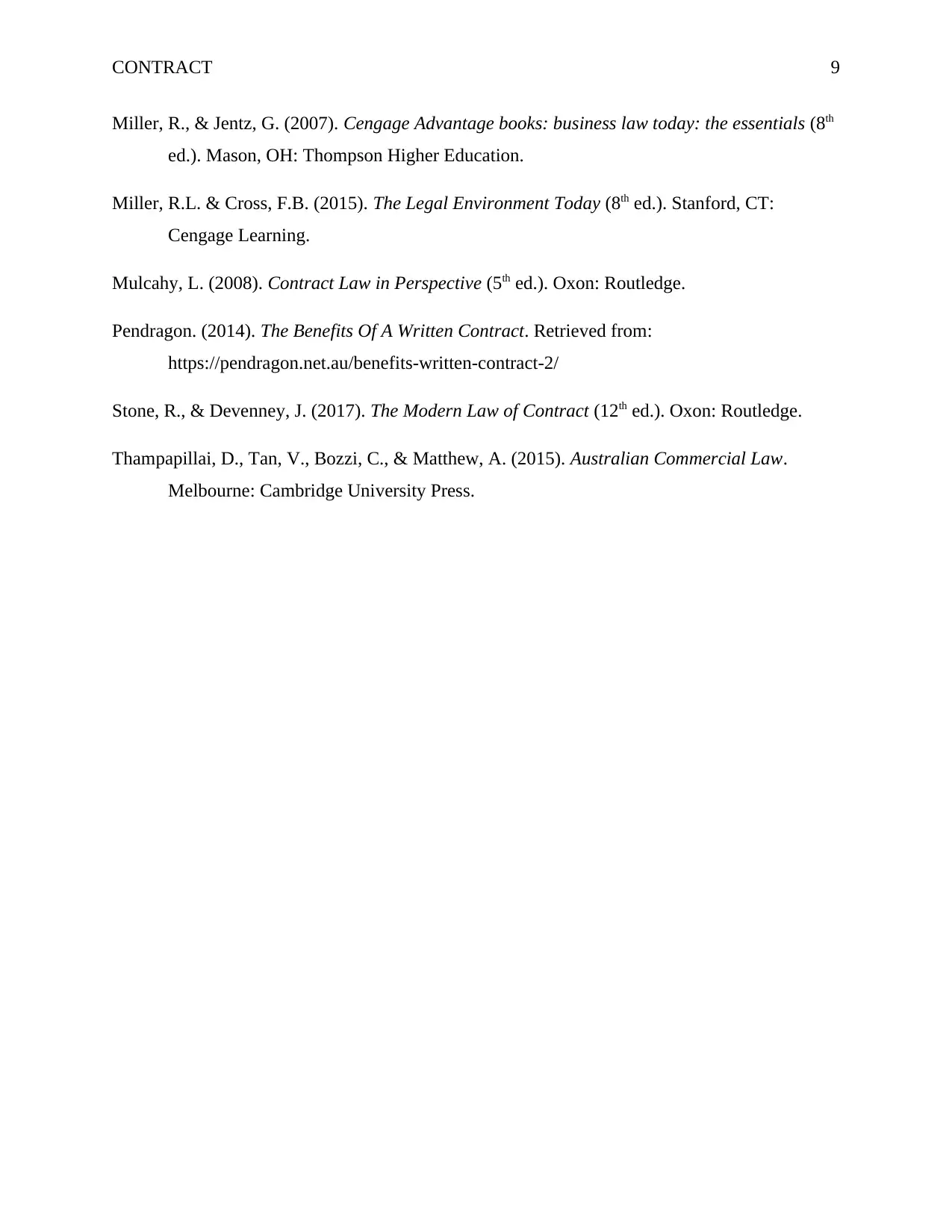
CONTRACT 9
Miller, R., & Jentz, G. (2007). Cengage Advantage books: business law today: the essentials (8th
ed.). Mason, OH: Thompson Higher Education.
Miller, R.L. & Cross, F.B. (2015). The Legal Environment Today (8th ed.). Stanford, CT:
Cengage Learning.
Mulcahy, L. (2008). Contract Law in Perspective (5th ed.). Oxon: Routledge.
Pendragon. (2014). The Benefits Of A Written Contract. Retrieved from:
https://pendragon.net.au/benefits-written-contract-2/
Stone, R., & Devenney, J. (2017). The Modern Law of Contract (12th ed.). Oxon: Routledge.
Thampapillai, D., Tan, V., Bozzi, C., & Matthew, A. (2015). Australian Commercial Law.
Melbourne: Cambridge University Press.
Miller, R., & Jentz, G. (2007). Cengage Advantage books: business law today: the essentials (8th
ed.). Mason, OH: Thompson Higher Education.
Miller, R.L. & Cross, F.B. (2015). The Legal Environment Today (8th ed.). Stanford, CT:
Cengage Learning.
Mulcahy, L. (2008). Contract Law in Perspective (5th ed.). Oxon: Routledge.
Pendragon. (2014). The Benefits Of A Written Contract. Retrieved from:
https://pendragon.net.au/benefits-written-contract-2/
Stone, R., & Devenney, J. (2017). The Modern Law of Contract (12th ed.). Oxon: Routledge.
Thampapillai, D., Tan, V., Bozzi, C., & Matthew, A. (2015). Australian Commercial Law.
Melbourne: Cambridge University Press.
⊘ This is a preview!⊘
Do you want full access?
Subscribe today to unlock all pages.

Trusted by 1+ million students worldwide
1 out of 9
Related Documents
Your All-in-One AI-Powered Toolkit for Academic Success.
+13062052269
info@desklib.com
Available 24*7 on WhatsApp / Email
![[object Object]](/_next/static/media/star-bottom.7253800d.svg)
Unlock your academic potential
Copyright © 2020–2025 A2Z Services. All Rights Reserved. Developed and managed by ZUCOL.





